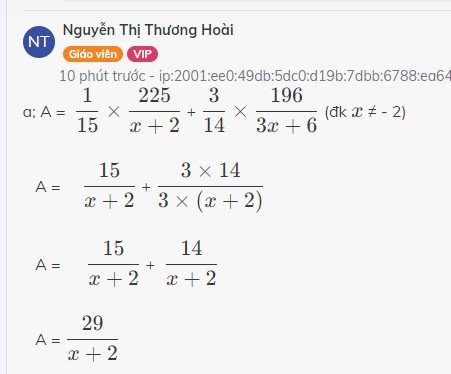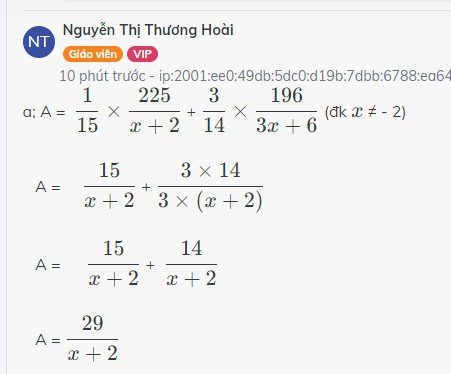Hãy nhập câu hỏi của bạn vào đây, nếu là tài khoản VIP, bạn sẽ được ưu tiên trả lời.

A = \(\dfrac{2x-1}{x+2}\)
a, A là phân số ⇔ \(x\) + 2 # 0 ⇒ \(x\) # -2
b, Để A là một số nguyên thì 2\(x-1\) ⋮ \(x\) + 2
⇒ 2\(x\) + 4 - 5 ⋮ \(x\) + 2
⇒ 2(\(x\) + 2) - 5 ⋮ \(x\) + 2
⇒ 5 ⋮ \(x\) + 2
⇒ \(x\) + 2 \(\in\) { -5; -1; 1; 5}
⇒ \(x\) \(\in\) { -7; -3; -1; 3}
c, A = \(\dfrac{2x-1}{x+2}\)
A = 2 - \(\dfrac{5}{x+2}\)
Với \(x\) \(\in\) Z và \(x\) < -3 ta có
\(x\) + 2 < - 3 + 2 = -1
⇒ \(\dfrac{5}{x+2}\) > \(\dfrac{5}{-1}\) = -5 ⇒ - \(\dfrac{5}{x+2}\)< 5
⇒ 2 - \(\dfrac{5}{x+2}\) < 2 + 5 = 7 ⇒ A < 7 (1)
Với \(x\) > -3; \(x\) # - 2; \(x\in\) Z ⇒ \(x\) ≥ -1 ⇒ \(x\) + 2 ≥ -1 + 2 = 1
\(\dfrac{5}{x+2}\) > 0 ⇒ - \(\dfrac{5}{x+2}\) < 0 ⇒ 2 - \(\dfrac{5}{x+2}\) < 2 (2)
Với \(x=-3\) ⇒ A = 2 - \(\dfrac{5}{-3+2}\) = 7 (3)
Kết hợp (1); (2) và(3) ta có A(max) = 7 ⇔ \(x\) = -3

a; A = \(\dfrac{1}{15}\) \(\times\) \(\dfrac{225}{x+2}\) + \(\dfrac{3}{14}\) \(\times\) \(\dfrac{196}{3x+6}\) (đk \(x\) ≠ - 2)
A = \(\dfrac{15}{x+2}\) + \(\dfrac{3\times14}{3\times\left(x+2\right)}\)
A = \(\dfrac{15}{x+2}\) + \(\dfrac{14}{x+2}\)
A = \(\dfrac{29}{x+2}\)
b; A = \(\dfrac{29}{x+2}\) (-2 ≠ \(x\) \(\in\) Z)
A \(\in\) Z ⇔ 29 ⋮ \(x\) + 2
\(x\) + 2 \(\in\) Ư(29) = {-29; - 1; 1; 29}
Lập bảng ta có:
| \(x\) + 2 | - 29 | - 1 | 1 | 29 |
| \(x\) | -31 | -3 | -1 | 27 |
Theo bảng trên ta có: \(x\) \(\in\) {- 31; -3; -1; 27}
Vậy \(x\) \(\in\) {-31; -3; -1; 27}

a: \(A=\left|x+1\right|+\left|y-2\right|\ge0\forall x,y\)
Dấu '=' xảy ra khi x=-1 và y=2
b: \(B=\left|x-4\right|+\left|y+6\right|\ge0\forall x,y\)
Dấu '=' xảy ra khi x=4 và y=-6

ta có \(\left|x+1\right|+\left|y-2\right|\ge0\)
\(\Leftrightarrow\left|x+1\right|+\left|y-2\right|=0\)
\(\Leftrightarrow\hept{\begin{cases}x+1=0\\y-2=0\end{cases}\Rightarrow\hept{\begin{cases}x=-1\\y=2\end{cases}}}\)
câu b tương tự
A ,B đều là tổng của hai số không âm=> nhỏ nhất KHi các số hạng của nó bằng 0
a)x+1=0; y-2=0
x=-1 và y=2
b)x=4 và y=-6

